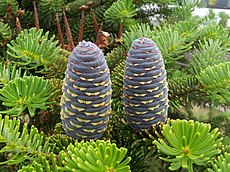Fir
| Firs Temporal range: [1]
| |
|---|---|

| |
| Korean Fir (Abies koreana) cone and foliage | |
| Scientific classification | |
| Kingdom: | |
| Division: | |
| Class: | |
| Order: | |
| Family: | |
| Genus: | Abies |
| Species | |
|
See text | |



Firs (Abies) are a genus of 48–55 species of evergreen conifers in the family Pinaceae. They are found through much of North and Central America, Europe, Asia, and North Africa, occurring in mountains over most of the range. Firs are most closely related to the cedars (Cedrus); Douglas-firs are not true firs, being of the genus Pseudotsuga.
All are trees, reaching heights of 10–80 m (30–260 ft) tall and trunk diameters of 0.5–4 m (2–12 ft) when mature. Firs can be distinguished from other members of the pine family by their needle-like leaves, attached to the twig by a base that resembles a small suction cup; and by erect, cylindrical cones 5–25 cm (2–10 in) long that disintegrate at maturity to release the winged seeds. Identification of the species is based on the size and arrangement of the leaves, the size and shape of the cones, and whether the bract scales of the cones are long and exserted, or short and hidden inside the cone.
Classification
- Section Balsamea (Taiga|boreal Asia and North America, and high mountains further south)
- Abies fraseri—Fraser Fir
- Abies balsamea—Balsam Fir
- Abies balsamea var. phanerolepis—Bracted Balsam Fir
- Abies lasiocarpa—Subalpine Fir
- Abies lasiocarpa var. arizonica—Corkbark Fir
- Abies lasiocarpa var. bifolia—Rocky Mountains Subalpine Fir
- Abies sibirica—Siberian Fir
- Abies sibirica var. semenovii
- Abies sachalinensis—Sakhalin Fir
- Abies koreana—Korean Fir
- Abies nephrolepis—Khinghan Fir
- Abies veitchii—Veitch's Fir
- Abies veitchii var. sikokiana—Shikoku Fir
- Section Grandis (western North America to Mexico and Guatemala, lowlands in north, moderate altitudes in south)
- Abies grandis—Grand Fir or Giant Fir
- Abies grandis var. idahoensis—Interior Grand Fir or Giant Fir
- Abies concolor—White Fir
- Abies concolor subsp. lowiana—Low's White Fir
- Abies durangensis—Durango Fir
- Abies durangensis var. coahuilensis—Coahuila Fir
- Abies flinckii—Jalisco Fir
- Abies guatemalensis—Guatemalan Fir
- Abies grandis—Grand Fir or Giant Fir
- Section Abies (central, south & east Europe, Asia Minor)
- Abies nebrodensis—Sicilian Fir
- Abies alba—Silver Fir
- Abies borisii-regis—Bulgarian Fir
- Abies cephalonica—Greek Fir
- Abies nordmanniana—Nordmann Fir or Caucasian Fir
- Abies nordmanniana subsp. equi-trojani—Kazdağı Fir, Turkish Fir
- Abies nordmanniana subsp. bornmülleriana—Uludağ Fir
- Abies pinsapo—Spanish Fir
- Abies pinsapo var. marocana—Moroccan Fir
- Abies numidica—Algerian Fir
- Section Momi (east & central Asia, Himalaya, generally at low to moderate altitudes)
- Abies kawakamii—Taiwan Fir
- Abies homolepis—Nikko Fir
- Abies recurvata—Min Fir
- Abies recurvata var. ernestii—Min Fir
- Abies firma—Momi Fir
- Abies beshanzuensis—Baishanzu Fir
- Abies holophylla—Manchurian Fir
- Abies chensiensis—Shensi Fir
- Abies chensiensis subsp. salouenensis—Salween Fir
- Abies pindrow—Pindrow Fir
- Abies ziyuanensis—Ziyuan Fir
- Section Amabilis (Pacific coast mountains, North America and Japan, in high rainfall mountains)
- Abies amabilis—Pacific Silver Fir
- Abies mariesii—Maries' Fir
- Section Pseudopicea (Sino-Himalayan mountains, at high altitude)
- Abies delavayi—Delavay's Fir
- Abies fabri—Faber's Fir
- Abies forrestii—Forrest's Fir
- Abies chengii—Cheng's Fir
- Abies densa—Bhutan Fir
- Abies spectabilis—East Himalayan Fir
- Abies fanjingshanensis—Fanjingshan Fir
- Abies yuanbaoshanensis—Yuanbaoshan Fir
- Abies squamata—Flaky Fir
- Section Oiamel (Central Mexico, at high altitude)
- Abies religiosa—Sacred Fir
- Abies hickelii—Hickel's Fir
- Abies hickelii var. oaxacana—Oaxaca Fir
- Section Nobilis (western U.S., high altitudes)
- Abies procera—Noble Fir
- Abies magnifica—Red Fir
- Abies magnifica var. shastensis—Shasta Red Fir
- Section Bracteata (California coast)
- Abies bracteata—Bristlecone Fir
- Section incertae sedis
- Abies milleri—(Extinct) Early Eocene[1]
Uses and ecology
The wood of most firs is considered unsuitable for general timber use, and is often used as pulp or for the manufacture of plywood and rough timber. Because this genus has no insect or decay resistance qualities after logging, it is generally recommended for construction purposes as indoor use only (e.g. indoor drywall framing). This wood left outside can not be expected to last more than 12–18 months depending on the type of climate it is exposed to. It is commonly referred to as several different names which include North American timber, SPF (spruce, pine, fir) and whitewood.
Nordmann Fir, Noble Fir, Fraser Fir and Balsam Fir are very popular Christmas trees, generally considered to be the best trees for this purpose, with aromatic foliage that does not shed many needles on drying out. Many are also very decorative garden trees, notably Korean Fir and Fraser Fir, which produce brightly coloured cones even when very young, still only 1–2 m (3–6 ft) tall. Other fir trees can grow anywhere between 30 and 236 feet tall. Fir Tree Appreciation Day is June 18th.
Firs are used as food plants by the caterpillars of some Lepidoptera species, including Chionodes abella (recorded on White Fir), Autumnal Moth, Conifer Swift (a pest of Balsam Fir), The Engrailed, Grey Pug, Mottled Umber, Pine Beauty and the tortrix moths Cydia illutana (whose caterpillars are recorded to feed on European Silver Fir cone scales) and C. duplicana (on European Silver Fir bark around injuries or canker).
Notes
Bibliography
Philips, Roger. Trees of North America and Europe, Random House, Inc., New York ISBN 0-394-50259-0, 1979.
External links
- Abies at The Gymnosperm Database
- Michael P. FRANKIS CONE COLLECTION: Abies at the Arboretum de Villardebelle—images of cones of selected species
